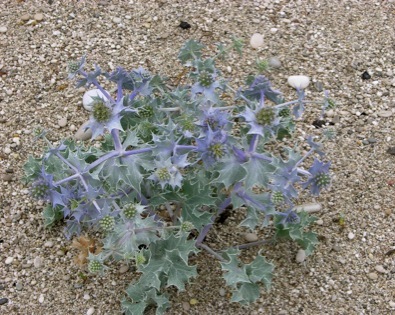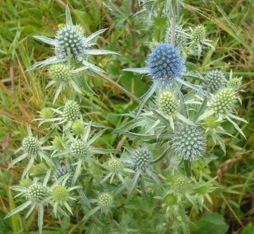Eryngiums: Elizabethan Eryngo Candy
While the edible versions are not widely distributed in North America, Eryngo (ERR-in-go) was too pretty a name to be left off my edibles list.
The two edible versions are Eryngium maritimum and Eryngium campestre. They are in the carrot family and are used similarly. Both are sparely distributed whereas their more ornamental cousins in the same family are widespread.
First E. maritimum, or the Sea Holly. On first glance when one sees the Sea Holly on the beach you think it is a lost thistle. The flower is burr-shaped but metallic blue, not pink white. It potential height, two feet, dwarfs the root’s potential depth up to…ah….down to 20 feet. No more than three is usual. Found naturally only near the sea it likes sand and is both a xerophyte and a halophyte, read it likes dry spots and salty spots.
Young leaves and shoots are blanched and prepared like asparagus. The roots were once sugared and sold as candy. They were peeled, boiled, and cut into slivers which were twisted together and then covered with sugar. The English town of Colchester was famous for the candied roots for centuries. The candy was much sought after for colds, coughs, and as an aphrodisiac. (An ancient recipe for candied Eryngo is below on bottom.) When the roots are boiled or roasted, they taste like cooked chestnuts and are quite nutritious.
Eryngium campestre has skinnier leaves and branches. It is also green where as the E. maritimum is blue-green. The E. campestre can grow by the sea but prefers to be inland in dry areas. Called Field Eryngo, it’s found more often in Europe than England but is also naturalized sporadically in North America.
Eryngium (ear-WREN-gee-um) is the Greek name for the plant latinized. It may come from the Greek word ‘erugarein’ meaning ‘to cure belching. Greek physician Dioscorides recommended the root to ease gas. Or it could come form ‘eerungos’, meaning ‘beard of a goat’. Plutarch recorded the effect of Sea Holly on goats: “It causes her first to stand still and afterwards the whole flock, until such time as the shepherd takes it from her.” Maritimum (mar-ih-TEE-mum) of or by the sea. Campestre (kam-PES-tree) means found in plains or similar flat or level places.
Green Deane’s “Itemized” Plant Profile
IDENTIFICATION: E. maritimus: spiny like a Holly, low growing but Thistle-like in appearance, bluish-green, stiffly hairy, spiny, leathery leaves, 3-lobed, folded. much-branched, numerous leaves, upper leaves clasping the stem, long thick roots. Flower heads, blue, are in heads with a whorl of stiff-colored bracts, spiny, petals narrow and deeply notched, turned down. E. campestre has slimmer or deeply cut leaves and stems and is green. It grows more upright
TIME OF YEAR: Flowers July and August
ENVIRONMENT: One likes it by the sea, one inland in grassy areas, both like full sun.
METHOD OF PREPARATION: Young shoots and tips are blanched then eaten like asparagus. Young shoots can be pickled. Roots can be candied, or boiled or roasted. The root is sweet but has little aroma. The plant is diuretic. Leaf juice was squeezed into ears to treat ear infections.
To candie orringo roots
Take fresh gathered oringo roots, set on a ketil of spring water, let it seeth, then put in ye roots & make them boyle as fast as a parsnep. Then cut them in ye midst & pick out theyr pith with a knife, then pill & throw them into a bason of aire water. Then wring them out of ye water & dry them with a cean cloth. Place them 3 or 4 together and tie them at each end with a third. Then take as much sugar as they weight & as much rose water & faire water together as will make a sirrup to cover them. Then set them over ye fire & dry them, after they are boyled in ye sirrup till it allmoste all boyled away & shaed in the bason to worke in ye sirrup. Then dry them by ye fire & box them for all ye year.
And creamed eryngo:
A 17th century recipe for ‘Eryngo cream’ by John Evelyn:: ‘Take halfe a pound of Eringo Roots and mince them very well then take an Ale pint of Creame sett them on the fire and boyle them with a piece of Isinglasse to thicken it boile a litle of it to trie the stiffnesses …



